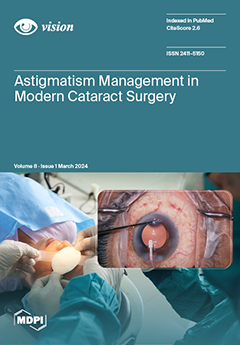This retrospective study evaluates the effectiveness of combining 0.05% atropine with MF60 contact lenses in managing rapid myopia progression in children over one year. The study involved three groups: the treatment group (TG) with 15 children (53% male, average age 12.9 ± 1.04),
[...] Read more.
This retrospective study evaluates the effectiveness of combining 0.05% atropine with MF60 contact lenses in managing rapid myopia progression in children over one year. The study involved three groups: the treatment group (TG) with 15 children (53% male, average age 12.9 ± 1.04), the MF group (MF) with 12 children (50% male, average age 12.8 ± 0.8) using only MF60 lenses, and the control group (CG) with 14 children (43% male, average age 12.1 ± 0.76). Baseline myopia and axial length (AL) were similar across groups, with the TG, MF, and CG showing −4.02 ± 0.70 D, −4.18 ± 0.89 D, −3.86 ± 0.99 D, and 24.72 ± 0.73 mm, 24.98 ± 0.70 mm, 24.59 ± 1.02 mm, respectively. Prior to the study, all groups exhibited significant myopia and AL progression, with no previous myopia control management. The treatment involved daily 0.05% atropine instillation, the use of MF60 lenses and increased outdoor activity. Biannual cycloplegic refraction and slit lamp evaluations confirmed no adverse reactions. After one year, the TG showed a significant reduction in myopia and AL progression (−0.43 ± 0.46 D,
p < 0.01; 0.22 ± 0.23 mm,
p < 0.01), whereas the CG showed minimal change (−1.30 ± 0.43 D,
p = 0.36; 0.65 ± 0.35 mm,
p = 0.533). The MF group also exhibited a notable decrease (−0.74 ± 0.45 D,
p < 0.01; 0.36 ± 0.23 mm). Increased outdoor activity during the treatment year did not significantly impact myopia control, suggesting its limited additional effect in this cohort. The study concludes that the combination of 0.05% atropine and peripheral defocus soft contact lenses effectively controls myopia progression in children.
Full article





